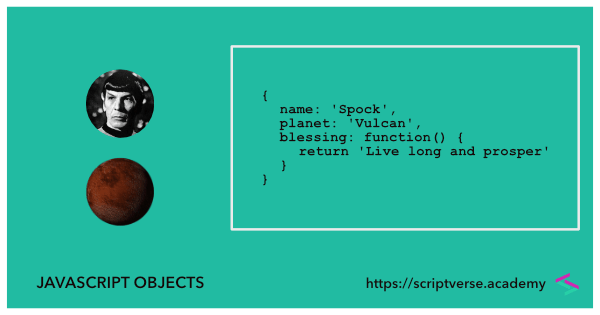Objects
Object Literal Notation
A JavaScript object is a collection of name-value pairs, called properties, separated by commas.
A property can also have a function as its value, in case of which it is known as a method. An object defined using braces {} is called an object literal.

Below is a sample object in JavaScript with property names name, planet and a method called blessing()
var member = {
name: "Spock",
planet: "Vulcan",
blessing: function() {
return "Live long and prosper"
}
};
Object properties and methods can be accessed either by using the dot notation, for example
> member.name; // Spock
> member.blessing(); // Live long and prosper
or by using the square bracket notation, for example
> member['planet']; // Vulcan
> member['blessing'](); // Live long and prosper
Constructor Function
Multiple similar objects with the same properties and methods can be created using constructor functions. First letter of constructor function names are capitalized to distinguish them from normal functions. A new object can be instantiated using the new keyword.
A constructor function called Member() is defined below with property names name, planet and a method called blessing(). A new instance of Member() is created using the new keyword and assigned to the variable member
function Member() {
this.name = "Spock";
this.planet = "Vulcan";
this.blessing = function() {
return "Live long and prosper";
}
};
var member = new Member();
The newly created object's properties and methods can be accessed as
> member.name; // Spock
> member.planet; // Vulcan
> member.blessing(); // Live long and prosper
Custom Constructor Function
Constructor functions can also be modified to accept parameters. Below we modify the Member() function shown above to pass two parameters and assign them to the name and planet properties respectively.
function Member(name, planet) {
this.name = name;
this.planet = planet;
};
On calling with the new keyword, objects can be created with initialized custom name and planet properties
var member1 = new Member("James T. Kirk", "Earth");
var member2 = new Member("Spock", "Vulcan");
> member1.name; // James T. Kirk
> member2.planet; // Vulcan
Singleton Function
The purpose of a singleton object is to limit the creation of objects, allowing its instantiation just once. An object literal is a simple example of a singleton (see the first section, above). In the example below, a self-instantiating function creates a singleton object called member via the new keyword.
var member = new function() {
this.name = "Spock";
this.planet = "Vulcan";
this.blessing = function() {
return "Live long and prosper";
}
};
> member.name; // Spock
> member.planet; // Vulcan
> member.blessing(); // Live long and prosper